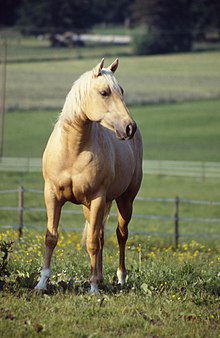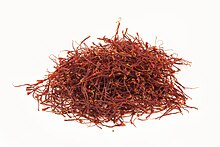Natural colors
The term natural colors has several meanings. This article covers the meanings as a hue or a palette of hues.
On the one hand, the term as an adjective or a noun in the singular means a color that results as a material property, such as the untreated, i.e. neither bleached nor colored color of the product. Natural colors are, for example, objects made from unbleached and undyed cotton or from unbleached paper.
On the other hand, the term (and then as plural , i.e. natural colors) describes a range of color tones. The designation here refers to the appearance of this color shade in nature or near-natural products, for example as a shade of earth (→ earth tones), wood or spices (→ spice tones). Undyed objects can be colored in these tones, but in the sense of the first meaning of the term they are not “natural colored”, but “colored”.
Color theory
Natural colors are pastel tones from the group of earth colors . The color range extends from clearly broken white to recognizable ( i.e. color-tinged ) brightly colored , but still light gray to warm , not very saturated color nuances. The colors range from almost green yellow to red . The gray levels have values between 10% and 30%, saturations are below 50%.
Natural colors
The natural color material property is used differently from the basic use in textile processing for the brownish off- white of the raw material in contrast to the pure white bleached goods . The same goes for paper and plastics . In all three branches, the undyed and unbleached, ie left “natural” product is called “natural colored”.
heraldry
In heraldry , the term “natural color” is used to describe common figures emblazoned in “natural colors” . It is marked with the heraldic tincture (one of the basic colors purple , brown , gray ), which can replace it.
Color names

For the property natural color are color names like Bright Yellow Gray , Gray Brown , Brown Green Gray used. Since the differentiation of different nuances of the "natural colors" in the usage of language is not particularly effective and the colorimetric relationships are not easy, one uses an abundance of trivial names for it . They are comparative names that refer to common materials found in nature. However, the natural substances obtained are not always of a clear shade of color.
- wood color : predominantly domestic species of wood are: spruce , pine , beech , larch , also nut or chestnut according to the fruit, or the actual or intentioned color of precious wood , of light tones up to the purple brown mahogany and the black tone ebony
- sand color : sahara
- clay colored
- earth-colored , in the whole range of brown tones, e.g. ocher (yellowish), siena (neutral brownish) , umbra (reddish brown) - all according to natural occurrence; See earth color and the reddish "burnt" earths up to brick / brick (-red)
- ivory (-color)
- taupe (after the mole's skin)
- fawn
- dough colors and bread roll brown
- cream-colored ([ ˈkrɛm or ˈkreːm ]), also called cream
- egg shell (the "unclean" white of a slightly colored chicken egg)
- tan , a color name that comes from English and stands for " browned " with the root word of tannin and a coloring process with natural substances
- drapp (-color) (Austrian)
These comparison names are not standardized within a color naming system and are interpreted differently from region to region. The sand as a natural template of "sand-colored" is more or less brown depending on the iron content of the soil. Other colors in nature can also be assessed differently. The association with "self-evident" objects in daily use is not constant from the outset over the course of time. In older specialist literature, dough colors are judged to be significantly darker, which could probably be attributed to the less frequent use of refined white flour in the past . On the other hand, the eggshell color refers more or less to “ brown eggs ”, not to the milk-white pieces.
Color names like beige , ecru (a wool white), isabel colors are mostly glossing over names that refer to "dirty" white. Apart from a few basic terms, many natural color names are largely determined by the fashion industry and other branches of industry with their annual design specifications. Nowadays, fashionable color names for natural tones are often used for lighter, less “dirty” shades of color.
Natural shade
In particular, the prefix “natural” or “natural” can reinforce the reference to the unchanged color. Such quotes are "natural blonde", "natural brown", "natural gray" or "natural gray" from the historical lexicon of German color names.
beige
The color beige [ ˈbeːʃ ] comprises a sequence of (indefinitely) warm, whitish brown tones. The word itself comes from French and became a synonym for natural colors in the 19th century . The color beige is specified in the RAL color system under the number RAL 1001. Then there are the nuances of green beige RAL 1000 Brown Beige RAL 1011 gray beige RAL 1019 and pearl beige RAL 1035th
Sand colors
In common usage, the term sand colors denotes unspecific reddish-white to yellowish-whitish color nuances. The RAL color nuance 1002 bears the name sand yellow .
Isabel colors
With isabellfarben a shade is usually referred to the color of a latte equivalent. The (inevitable) inaccuracy of color names through comparison also applies here, since the proportion of milk in the coffee influences the nuance.
This color name is especially used in animal breeding to denote the fur color of animals. Examples of this are isabel-colored horses , the fur drawings of certain breeds of dogs and pen drawings of different species of birds. Until the mid-1950s, cats in brown tones were listed as isabel colors.
The color name is said to have been formed by the Spanish princess Isabella Clara Eugenia , daughter of Philip II and governor of the Spanish Netherlands . She vowed that she did not want to change her originally white shirt until her husband, Archduke Albrecht VII of Habsburg , had conquered the city of Ostend , which he began to besiege in 1601. Since this siege lasted three years, three months and three days until 1604, the significance of the legend regarding the color cannot be doubted. A variant of the legend connects the shirt of Queen Isabella the Catholic with the three-year siege of the Moorish Granada .
Ecru
Ecru or Germanized Ekrü comes from the French word écru for "unbleached", "untreated". It refers to raw silk (also "ecruiside") and was later transferred to the slightly green shade of white of the fabric.
Fawn colors
Falb originally referred to the discoloration of flowers and trees, especially before they shed their leaves in autumn. While it was still used in this sense in the 19th century, for example by Herder , “the leaves are already falling”, today it is used more like the German words yellow and pale . It is mainly used as the color of horses, the Fallows .
Chamois
Chamois is French and means " Gämse " ( Middle High German gamz ). This is probably what the color name refers to, ie "like a light chamois leather ".
ivory
Ivory is a special form of the tooth structure of various animals, particularly the elephant and the fossilized tusks of the mammoth . The substance is different from human teeth. Even under the skin, ivory is of a fine off-white similar to milk, but the substance, which has aged through contact with air, has a distinct brownish tinge. Ivory is specified by RAL 1014 and light ivory by RAL 1015. Until 2004, light ivory was a legal requirement for taxis in Germany. RAL 1013, the similar pearl white , gets its name from the pigment lead white .
The color name "ivory black " goes back to the leg black , a dye that was originally obtained from ivory that was annealed in the absence of air.
Individual evidence
- ↑ according to Duden : word separation: el | fen | bein | far | ben / overview of meanings: of the color of ivory, yellowish white like ivory.
- ↑ see Tan (color) - entry in the English Wikipedia (August 20, 2006)
- ^ William Jervis Jones: Historical Lexicon of German Color Designations . Volume IV Early New High German – New High German L – R, Akademie-Verlag, Berlin 2013, pp. 1948/1949, ISBN 978-3-05-006322-5
- ↑ Entry Isabel color in Meyers Konversationslexikon
- ^ Entry Falben in Grimm: German Dictionary . dwb.uni-trier.de online .
- ↑ Elfenbein ( Memento of March 22, 2016 in the Internet Archive ) In: Adolf Beythien , Ernst Dressler (Ed.): Merck's Lexicon of Goods for Trade, Industry and Commerce. 7th edition. Gloeckner, Leipzig 1920. (Reprint: Manuscriptum, Recklinghausen 1996. ISBN 3-933497-13-2 ).
Remarks
Color terms can also be found in the Duden.
- ↑ a b according to Duden : word separation: sand | far | ben / related form: sand-colored / overview of meanings: beige.
- ↑ Duden : creme / Examples: a creme dress; in cream [rule 72] / overview of meanings matt yellow, yellowish / synonyms for cream; beige, creamy white, eggshell colored, ivory colored, yellowish [white], dull yellow, sand colored; (Austrian) drapp [colors] / Spelling recommended by Duden: cream-colored, alternative spelling: cream-colored / word separation: creme | far | ben, crème | far | ben.
- ↑ according to Duden : word separation: egg | er | shells | colors / overview of meanings yellowish white / synonyms for egg shell colors: cream colored; beige, cream, cream-white, ivory-colored, yellowish [white], matt yellow, sand-colored; (Austrian) drapp [colors] / emphasis: egg shell-colored.
- ↑ according to Duden : word separation: drapp | far | ben / related form: drapp / overview of meanings: sand-colored (of fabrics) / emphasis: drạppfarben / origin in French drap, drap.
- ↑ according to Duden : word separation: beige / overview of meanings: showing the color of the dune sand / examples: a beige / beige [ˈbeːʒəs] dress, we have painted the furniture beige / synonyms for beige: cream; cream, creamy white, eggshell-colored, ivory-colored, yellowish [white], matt yellow, sand-colored; (Austrian) drapp [colors] / Pronunciation: [beːʃ] ?, [bɛːʃ] ? / Origin: French beige, origin unclear / Grammar: Strong inflection



